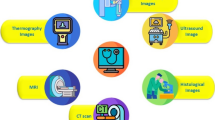Abstract
Only one third of all breast cancer biopsies made today confirm the disease, which make these procedures inefficient and expensive. We address the problem by exploring and comparing characteristics of four neural networks used as predictors: fuzzy, distributed, default, and ic ARTMAP, all based on the adaptive resonance theory. The networks were trained using a dataset that contains a combination of 39 mammographic, sonographic, and other descriptors, which is novel for the field. We compared the model performances by using ROC analysis and metrics derived from it, such as max accuracy, full and partial area under the convex hull, and specificity at 98% sensitivity. Our findings show that the four models outperform the most popular MLP neural networks given that they are setup properly and used with appropriate selection of data variables. We also find that two of the models, distributed and ic, are too conservative in their predictions and do not provide sufficient sensitivity and specificity, but the default ARTMAP shows very good characteristics. It outperforms not only its counterparts, but also all other models used with the same data, even some radiologist practices. To the best of our knowledge, the ARTMAP neural networks have not been studied for the purpose of the task until now.
Access this chapter
Tax calculation will be finalised at checkout
Purchases are for personal use only
Preview
Unable to display preview. Download preview PDF.
Similar content being viewed by others
References
American College of Radiology: BI-RADS: ultrasound, 1st ed. In: Breast Imaging Reporting and Data System: BI-RADS atlas, 4th, VA: Am. College of Radiology (2003)
Carpenter, G., Grossberg, S., Reynolds, J.: ARTMAP: Supervised Real-Time Learning and Classification of Non-stationary Data by a Self-Organizing Neural Network. Neural Networks 6, 565–588 (1991)
Carpenter, G., Grossberg, S., Markuzon, N., Reynorlds, J., Rosen, D.: Fuzzy ARTMAP: A Neural Network Architecture for Incremental Supervised Learning of Analog Multidimensional Maps. IEEE Transaction on Neural Networks 3(5), 698–713 (1992)
Carpenter, G.: Distributed Learning, Recognition, and Prediction by ART and ARTMAP Neural Networks. Neural Networks 10(8), 1473–1494 (1997)
Carpenter, G., Markuzon, N.: ARTMAP-IC and Medical Diagnosis: Instance Counting and Inconsistent Cases. Neural Networks 11(2), 323–336 (1998)
Carpenter, G.: Default ARTMAP. In: Proceedings of the International Joint Conference on Neural Networks (IJCNN 2003), Portland, Oregon, pp. 1396–1401 (2003)
Chen, S., Hsiao, Y., Huang, Y., Kuo, S., Tseng, H., Wu, H., Chen, D.: Comparative Analysis of Logistic Regression, Support Vector Machine and Artificial Neural Network for the Differential Diagnosis of Benign and Malignant Solid Breast Tumors by the Use of Three-Dimensional Power Doppler Imaging. Korean J. Radiol. 10, 464–471 (2009)
Fawcett, T.: An introduction to ROC analysis. Pattern Recognition Letters 27(8), 861–874 (2006)
Goldberg, D.: Genetic Algorithms in Search, Optimization, and Machine Learning. Addison-Wesley, Reading (1989)
Grossberg, S.: Adaptive Pattern Recognition and Universal Encoding II: Feedback, expectation, olfaction, and illusions. Biological Cybernetics 23, 187–202 (1976)
Hall, M.: Correlation based feature selection for machine learning. PhD dissertation, Dept. of Computer Science, The University of Waikato, Hamilton, New Zealand (1999)
Jesneck, J., Nolte, L., Baker, J., Floyd, C., Lo, J.: Optimized Approach to Decision Fusion of Heterogeneous Data for Breast Cancer Diagnosis. Med. Phys. 33(8), 2945–2954 (2006)
Jesneck, J., Lo, J., Baker, J.: Breast Mass Lesions: Computer-Aided Diagnosis Models with Mamographic and Sonographic Descriptors. Rad. 244(2), 390–398 (2007)
Lacey, J., Devesa, S., Brinton, L.: Recent Trends in Breast Cancer Incidence and Mortality. Environmental and Molecular Mutagenesis 39, 82–88 (2002)
Nachev, A., Stoyanov, B.: An Approach to Computer Aided Diagnosis by Multi-Layer Preceptrons. In: Proc. of International Conference Artificial Intelligence, Las Vegas (2010)
Stavros, A., Thickman, D., Rapp, C., Dennis, M., Parker, S., Sisney, G.: Solid Breast Modules: Use of Sonography to Destinguish between Benign and Malignant Lesions. Radiology 196, 123–134 (1995)
Author information
Authors and Affiliations
Editor information
Editors and Affiliations
Rights and permissions
Copyright information
© 2010 Springer-Verlag Berlin Heidelberg
About this paper
Cite this paper
Nachev, A. (2010). Comparative Analysis of Distributed, Default, IC, and Fuzzy ARTMAP Neural Networks for Classification of Malignant and Benign Lesions . In: Dicheva, D., Dochev, D. (eds) Artificial Intelligence: Methodology, Systems, and Applications. AIMSA 2010. Lecture Notes in Computer Science(), vol 6304. Springer, Berlin, Heidelberg. https://doi.org/10.1007/978-3-642-15431-7_22
Download citation
DOI: https://doi.org/10.1007/978-3-642-15431-7_22
Publisher Name: Springer, Berlin, Heidelberg
Print ISBN: 978-3-642-15430-0
Online ISBN: 978-3-642-15431-7
eBook Packages: Computer ScienceComputer Science (R0)





